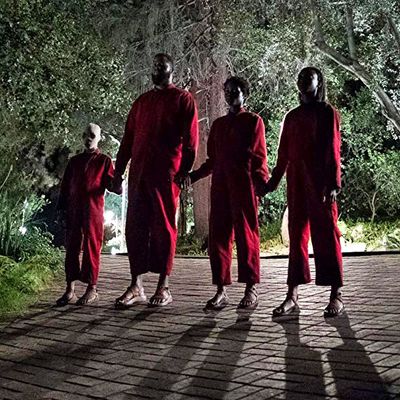
Jordan Peele’s Us opens with a sequence that seems deliberately designed to confuse viewers, or, at least, younger ones. On a vintage television, surrounded by VHS tapes, we see a promotional video for Hands Across America, an advertisement (and event) so fundamentally cheeseball, it almost seems like something Peele made up. But as with Gremlins 2: The New Batch, the truth of ’80s entertainment was stranger than fiction, and Hands Across America was very real indeed, a true relic of the era — in terms of both its aims and its failed ambitions.
Hands Across America was part of a wider movement of celebrity/entertainment activism that swept the country, and the world, in the mid-1980s. It was a snowball effect, each all-star benefit prompting another that attempted to complement or outdo its predecessor: Bob Geldof’s 1984 Band Aid single “Do They Know It’s Christmas?” begot an American counterpart, “We Are the World,” which became the fastest-selling pop single of all time upon its release in March of 1985; U.S.A. for Africa, the organization behind the single, teamed with Geldof to mount the global benefit concert Live Aid that July.
And in October of 1985, U.S.A. for Africa announced its topper: On Sunday, May 25, 1986, 6 million Americans would lock hands and form a line winding from New York City to Long Beach, California. Each participant would contribute $10 toward the cause of aiding the country’s homeless and hungry; sponsors (including Coca-Cola and Citibank) would, they said, cover the estimated $18.8 million cost of staging, advertising, and staffing the event. U.S.A. for Africa called it “the largest participatory event in the history of the world,” and hoped to raise “at least $50 million.”
Organization was, unsurprisingly, a logistical nightmare, particularly in that pre-internet, pre–cell phone age. The intended 4,152-mile route, stretching across 16 states, ten rivers, two deserts, and one mountain range, required 1,320 participants per mile. To volunteer for a spot, individuals could pledge their $10 (or more, if they wanted a T-shirt, pin, or other swag) via an 800 number, which would then send them an entry form. “When the form is returned,” the New York Times reported, “the organization’s computer assigns a particular one-mile segment.” (We were really excited about our computers in the 1980s.) Corporate and individual sponsors could buy entire miles of the route; some offered to transport participants to fill them. But there were still questions about how to fill predicted gaps in Texas and through the Southwest, and about the route itself. (Senator Ted Kennedy complained that the route bypassed New England). Some even wondered if so many people linking bodies could prove an electrical danger.
And then there was the question of star power. Part of the draw of “We are the World” and Live Aid were the white-hot personnel: Michael Jackson and Lionel Richie co-wrote and anchored the song, while David Bowie, the Who, Queen, Elton John, Sting, Madonna, and Tom Petty were among the headliners at the concert. Hands Across America lined up Lily Tomlin, Kenny Rogers, Pete Rose, and (gulp) Bill Cosby as co-chairs, and more stars committed to participate on the day or sponsor miles. But the “Hands Across America” theme song was a decidedly low-rent affair, written by a trio of commercial jingle composers (their biggest hit was Chrysler’s “The Pride is Back”), performed by studio singers, a New Jersey choir, and Toto, of “Africa” fame. In spite of a music video boasting cameos by the likes of Barbra Streisand, Robin Williams, and C3PO, the song flopped.
In the week leading up to the event, a mini-controversy brewed. Days before Hands Across America, President Ronald Reagan responded to criticism of his budget’s reductions to poverty assistance by proclaiming that there were enough resources available to the country’s poor. “I don’t believe that there is anyone going hungry in America simply by reason of denial or lack of ability to feed them,” Reagan said. “It is by people not knowing where or how to get this help.” When those comments attracted criticism of their own, the president and his staff recognized the public-relations value of Hands Across America, and carefully placed themselves between adorable moppets for an official White House video at 3 p.m. sharp on the Sunday before Memorial Day.
Participants across the country held hands for 15 minutes that day, with radios tuned to stations participating in a simulcast, so all could sing along to “We Are the World,” “America the Beautiful,” and the sappy “Hands Across America” theme. Other Washington, D.C., participants included Reverend Billy Graham, Mary Lou Retton, and Coretta Scott King. Jesse Jackson joined the line in Iowa; Bill and Hillary Clinton lent a hand in Arkansas; Mickey Mouse and Donald Duck joined in at Disneyland. Migrant workers organized a 51-mile stretch in Texas. The chain also included 50 Abraham Lincoln impersonators in Springfield, Illinois, and 54 Elvises in Memphis. The AP reported five weddings along the chain.
But even the most optimistic reports noted “several gaps” in the line, some of them miles long; ribbons, banners, and even farm animals were used to fill in the noticeable voids. And optics weren’t the only problem; due to astronomical administrative costs and unkept pledges, Hands Across America fell far short of its $50 million goal. A year later, the Times reported a net of “only $15 million for the hungry and homeless after all costs were paid.” U.S.A. for Africa spent about the same amount to mount the event.
That relatively small payout, and the goofy music video, were Hands Across America’s legacy — until now. Jordan Peele was 7 years old (roughly the same age as little Adelaide in Us) at the time of Hands Across America. And maybe it took eyes that young to look at this sweaty attempt at ’80s activism and see something not corny, not self-aggrandizing, but deeply, undeniably sinister.




